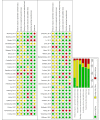Virtual Patient Simulations in Health Professions Education: Systematic Review and Meta-Analysis by the Digital Health Education Collaboration
- PMID: 31267981
- PMCID: PMC6632099
- DOI: 10.2196/14676
Virtual Patient Simulations in Health Professions Education: Systematic Review and Meta-Analysis by the Digital Health Education Collaboration
Abstract
Background: Virtual patients are interactive digital simulations of clinical scenarios for the purpose of health professions education. There is no current collated evidence on the effectiveness of this form of education.
Objective: The goal of this study was to evaluate the effectiveness of virtual patients compared with traditional education, blended with traditional education, compared with other types of digital education, and design variants of virtual patients in health professions education. The outcomes of interest were knowledge, skills, attitudes, and satisfaction.
Methods: We performed a systematic review on the effectiveness of virtual patient simulations in pre- and postregistration health professions education following Cochrane methodology. We searched 7 databases from the year 1990 up to September 2018. No language restrictions were applied. We included randomized controlled trials and cluster randomized trials. We independently selected studies, extracted data, and assessed risk of bias and then compared the information in pairs. We contacted study authors for additional information if necessary. All pooled analyses were based on random-effects models.
Results: A total of 51 trials involving 4696 participants met our inclusion criteria. Furthermore, 25 studies compared virtual patients with traditional education, 11 studies investigated virtual patients as blended learning, 5 studies compared virtual patients with different forms of digital education, and 10 studies compared different design variants. The pooled analysis of studies comparing the effect of virtual patients to traditional education showed similar results for knowledge (standardized mean difference [SMD]=0.11, 95% CI -0.17 to 0.39, I2=74%, n=927) and favored virtual patients for skills (SMD=0.90, 95% CI 0.49 to 1.32, I2=88%, n=897). Studies measuring attitudes and satisfaction predominantly used surveys with item-by-item comparison. Trials comparing virtual patients with different forms of digital education and design variants were not numerous enough to give clear recommendations. Several methodological limitations in the included studies and heterogeneity contributed to a generally low quality of evidence.
Conclusions: Low to modest and mixed evidence suggests that when compared with traditional education, virtual patients can more effectively improve skills, and at least as effectively improve knowledge. The skills that improved were clinical reasoning, procedural skills, and a mix of procedural and team skills. We found evidence of effectiveness in both high-income and low- and middle-income countries, demonstrating the global applicability of virtual patients. Further research should explore the utility of different design variants of virtual patients.
Keywords: computer simulation; computer-assisted instruction; meta-analysis; professional education; systematic review.
©Andrzej A Kononowicz, Luke A Woodham, Samuel Edelbring, Natalia Stathakarou, David Davies, Nakul Saxena, Lorainne Tudor Car, Jan Carlstedt-Duke, Josip Car, Nabil Zary. Originally published in the Journal of Medical Internet Research (http://www.jmir.org), 02.07.2019.
Conflict of interest statement
Conflicts of Interest: None declared.
Figures








References
-
- Dev P, Schleyer T. Computers in health care education. In: Shortliffe E, Cimino J, editors. Biomedical Informatics. London: Springer; 2014. pp. 675–93.
-
- Frenk J, Chen L, Bhutta ZA, Cohen J, Crisp N, Evans T, Fineberg H, Garcia P, Ke Y, Kelley P, Kistnasamy B, Meleis A, Naylor D, Pablos-Mendez A, Reddy S, Scrimshaw S, Sepulveda J, Serwadda D, Zurayk H. Health professionals for a new century: transforming education to strengthen health systems in an interdependent world. Lancet. 2010 Dec 4;376(9756):1923–58. doi: 10.1016/S0140-6736(10)61854-5.S0140-6736(10)61854-5 - DOI - PubMed
Publication types
MeSH terms
LinkOut - more resources
Full Text Sources
Medical
Miscellaneous

